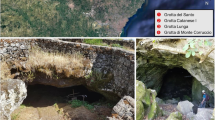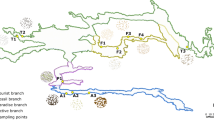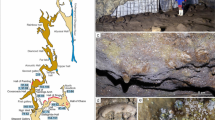Abstract
The Vjetrenica cave in the Dinaric Karst hosts a worldwide extraordinarily high cave biodiversity. Beside a diverse and specialized cave fauna, sprout-like formations attached to the bed of the cave stream were observed and described, but not further characterized, almost a century ago. Here we investigated these sprout-like microbial aggregates by the rRNA approach and detailed microscopy. Based on fluorescence in situ hybridization and ultrastructural analysis, the sprout-like formations are morphologically highly organized, and their core consists of a member of a novel deep-branching lineage in the bacterial phylum Nitrospirae. This organism displays an interesting cellular ultrastructure with different kinds of cytoplasmic inclusions and is embedded in a thick extracellular matrix, which contributes to the stability and shape of the aggregates. This novel bacterium has been provisionally classified as “Candidatus Troglogloea absoloni.” The surface of the sprout-like aggregates is more diverse than the core. It is colonized by a bacterial biofilm consisting primarily of filamentous Betaproteobacteria, whereas other microbial populations present in the crust include members of the Bacteriodetes, Gammaproteobacteria, Actinombacteria, Alphaproteobacteria, and Planctomycetes, which are intermingled with mineral inclusions. This study represents the first thorough molecular and ultrastructural characterization of the elusive sprout-like bacterial aggregates, which are also found in other cave systems of the Dinaric Karst. The discovery of Ca. Troglogloea absoloni contributes to the known biodiversity of subterranean ecosystems and especially of macroscopic structures formed in caves by microorganisms, whose composition and ecological function often remain enigmatic.








Similar content being viewed by others
References
Amann RI, Krumholz L, Stahl DA (1990) Fluorescent-oligonucleotide probing of whole cells for determinative, phylogenetic, and environmental studies in microbiology. J Bacteriol 172:762–770
Amann RI, Ludwig W, Schleifer K-H (1995) Phylogenetic identification and in situ detection of individual microbial cells without cultivation. Microbiol Rev 59:143–169
Burdon KL (1946) Fatty material in bacteria and fungi revealed by staining dried, fixed slide preparation. J Bacteriol 52:665–678
Chen Y, Wu L, Boden R, Hillebrand A, Kumaresan D, Moussard H, Baciu M, Lu Y, Colin Murrell J (2009) Life without light: microbial diversity and evidence of sulfur- and ammonium-based chemolithotrophy in Movile Cave. ISME J 3:1093–1104
Christiansen KA (1962) Proposition pour la classification des animaux cavernicoles. Spelunca 2:76–78
Cole JR, Wang Q, Cardenas E, Fish J, Chai B, Farris RJ, Kulam-Syed-Mohideen ASD, McGarrell M, Marsh T, Garrity GM, Tiedje JM (2008) The Ribosomal Database Project: improved alignments and new tools for rRNA analysis. Nucl Acids Res 37:D141–D145
Crabtree K, McCoy E (1967) Zoogloea ramigera Itzigsohn, identification and description. Int J Syst Bacteriol 17:1–10
Culver DC (1985) Trophic relationships in aquatic environments. Stygologia 1:43–53
Culver DC, Sket B (2000) Hotspots of subterranean biodiversity in caves and wells. J Cave Karst Stud 62:11–17
Daims H, Brühl A, Amann R, Schleifer K-H, Wagner M (1999) The domain-specific probe EUB338 is insufficient for the detection of all Bacteria; development and evaluation of a more comprehensive probe set. Syst Appl Microbiol 22:434–444
Daims H, Nielsen JL, Nielsen PH, Scleifer K-H, Wagner M (2001) In situ characterization of Nitrospira-like nitrite-oxydizing bacteria in wastewater treatment plants. Appl Environ Microbiol 67:5273–5284
Daims H, Stoecker K, Wagner M (2005) Fluorescence in situ hybridisation for the detection of prokaryotes. In: Osborn AM, Smith CJ (eds) Molecular microbial ecology. Bios-Garland, Abingdon, pp 213–239
DeLong EF (1992) Archaea in coastal marine environments. Proc Natl Acad Sci U S A 89:5685–5689
Edgar RC (2004) MUSCLE: multiple sequence alignment with high accuracy and high throughput. Nucl Acids Res 32:1792–1797
Ehrich S, Behrens D, Lebedeva E, Ludwig W, Bock E (1995) A new obligately chemolithoautotrophic, nitrite oxidizing bacterium, Nitrospira moscoviensis sp. nov., and its phylogenetic relationship. Arch Microbiol 164:16–23
Engel AS (2010) Microbial diversity of cave ecosystems. In: Barton L, Mandl M, Loy A (eds) Geomicrobiology: Molecular, Environmental Perspectives. Springer, Berlin, pp 219–238
Farnleitner A, Wilhartitz I, Kirschner AKT, Stadler H, Burtscher MM, Hornek R, Szewzyk U, Herndl G, Mach R (2005) Bacterial dynamics in spring water of alpine karst aquifers indicates the presence of stable autochthonous microbial endokarst communities. Environ Microbiol 7:1248–1259
Friedman BA, Dugan PR, Pfister RM, Remsen CC (1968) Fine structure and composition of the Zoogloeal matrix surrounding Zoogloea ramigera. J Bacteriol 96:2144–2153
Friedman BA, Dugan PR (1968) Identification of Zoogloea species and the relationship to zoogloeal matrix and floc formation. J Bacteriol 95:1903–1909
Glöckner FO, Fuchs BM, Amman R (1999) Bacterioplankton compositions of lake and oceans: a first comparison based of fluorescence in situ hybridization. Appl Environ Microbiol 65:3721–3726
Good IJ (1953) The population frequencies of species and the estimation of population parameters. Biometrika 40:237–264
Guindon S, Gascuel O (2003) A simple, fast, and accurate algorithm to estimate large phylogenies by maximum likelihood. Syst Biol 52:696–704
Haouari O, Fardeau ML, Cayol JL, Fauque G, Casiot C, Elbaz-Poulichet F, Hamdi M, Ollivier B (2008) Thermodesulfovibrio hydrogeniphilus sp. nov., a new thermophilic sulphate-reducing bacterium isolated from a Tunisian hot spring. Syst Appl Microbiol 31:38–42
Henry EA, Devereux R, Maki JS, Gilmour CC, Woese CR, Mandelco L, Schauder R, Remsen CC, Mitchell R (1994) Characterization of a new thermophilic sulfate-reducing bacterium Thermodesulfovibrio yellowstonii, gen. nov. and sp. nov.: its phylogenetic relationship to Thermodesulfobacterium commune and their origins deep within the bacterial domain. Arch Microbiol 161:62–69
Hippe H (2000) Leptospirillum gen. nov. (ex Markosyan 1972), nom. rev., including Leptospirillum ferrooxidans sp. nov. (ex Markosyan 1972), nom. rev. and Leptospirillum thermoferrooxidans sp. nov. (Golovacheva et al. 1992). Int J Syst Evol Microbiol 50:501–503
Holmes AJ, Tujula NA, Holley M, Contos A, James JM, Rogers P, Gillings MR (2001) Phylogenetic structure of unusual aquatic microbial formations in Nullarbor caves, Australia. Environ Microbiol 3:256–264
Huang WE, Stoecker K, Griffiths R, Newbold L, Daims H, Whiteley AS, Wagner M (2007) Raman-FISH: combining stable-isotope Raman spectroscopy and fluorescence in situ hybridization for the single cell analysis of identity and function. Environ Microbiol 9:1878–1889
Huber T, Faulkner G, Hugenholtz P (2004) Bellerophon: a program to detect chimeric sequences in multiple sequence alignments. Bioinformatics 20:2317–2319
Huelsenbeck JP, Ronquist F (2001) MRBAYES: Bayesian interface of phylogenetic trees. Bioinformatics 17:754–755
Inglis TJJ, Sagripanti J-L (2006) Environmental factors that affect the survival and presistance of Burkholderia pseudomallei. Appl Environ Microbiol 72:6865–6875
Jones DA, Lyon EH, Macalady JL (2009) Geomicrobiology of biovermiculations from the Frasassi cave system, Italy. J Cave Karst Stud 70:78–93
Jogler C, Niebler M, Lin W, Kube M, Wanner G, Kolinko S, Stief P, Beck AJ, De Beer D, Petersen N, Pan Y, Amann R, Reinhardt R, Schüler D (2010) Cultivation-independent characterization of 'Candidatus Magnetobacterium bavaricum' via ultrastructural, geochemical, ecological and metagenomic methods. Environ Microbiol 12(9):2466–2478
Lane DJ (1991) 16S/23S rRNA sequencing. In: Stackebrandt E, Goodfellow M (eds) Nucleic acid techniques in bacterial systematic. Wiley, New York, pp 115–175
Lebedeva EV, Off S, Zumbrägel S, Krause M, Shagzhina A, Lücker S, Maxiner F, Lipski A, Daims H, Spieck E (2011) Isolation and characterization of a moderately thermophilic nitrite-oxidizing bacterium from geithrmal spring. FEMS Microbiol Ecol 75:195–204
Lechene CP, Luyten Y, McMahon G, Distel DL (2007) Quantitative imaging of nitrogen fixation by individual bacteria within animal cells. Science 317:1563–1566
Lee N, Nielsen PH, Andreasen KH, Juretschko S, Nielsen JL, Schleifer K-H, Wagner M (1999) Combination of fluorescent in situ hybridization and microautoradiography—a new tool for structure-function analyses in microbial ecology. Appl Environ Microbiol 65:1289–1297
Loy A, Arnold R, Tischler P, Rattei T, Wagner M, Horn M (2008) probeCheck—a central resource for evaluating oligonucleotide probe coverage and specificity. Environ Microbiol 10:2894–2896
Lučić I (2003) Vjetrenica, insight into the Earth's soul. ArTresor, Zagreb
Macalady JL, Lyon EH, Koffmann B, Albertson LK, Meyer K, Galdenzi S, Mariani S (2006) Dominant microbial populations in limestone-corroding stream biofilms, Frasassi cave system, Italy. Appl Environ Microbiol 72:5596–5609
Macalady JL, Jones DS, Lyon EH (2007) Extremely acidic, pendulous cave wall biofilms from the Frasassi cave system, Italy. Environ Microbiol 9:1402–1414
Manz W, Amann R, Ludwig W, Wagner M, Schleifer K-H (1992) Phylogenetic oligodeoxynucleotide probes for the major subclasses of proteobacteria: problems and solutions. Syst Appl Microbiol 15:593–600
Markosyan GE (1972) A new iron-oxidizing bacterium—Leptospirillum ferrooxidans nov. gen. nov. sp. Biol J Armenia 25:26–29
Megušar F, Sket B (1977) On the nature of some organic covers on the cave walls. Proceedings of the 6th International Congress of Speleology. Olomouc 5:159–161
Murray RGE, Stackebrandt E (1995) Taxonomic note: implementation of the provisional status Candidatus for incompletely described procaryotes. Int J Syst Bacteriol 45:186–187
Northup DE, Lavoie KH (2004) Microorganisms in caves. In: Gunn J (ed) Encyclopedia of caves and karst Sicene. Taylor and Francis Books, New York, pp 1083–1089
Northup DE, Melim LA, Spilde MN, Hathaway JMM, Garcia MG, Moya M, Stone FD, Boston PJ, Dapkevicius MLNE, Riquelme C (2011) Lava cave microbial communities within mats and secondary mineral deposits: implications for life detection on other planets. Astrobiology 11:601–618
Ostle AG, Holt JG (1982) Nile blue A as a fluorescent stain for poly-3-hydroxybutyrate. Appl Environ Microbiol 44:238–241
Ozimec R, Lučić I (2009) The Vjetrenica cave (Bosnia and Herzegovina)—one of the world’s most prominent biodiversity hotspots for cave-dwelling fauna. Subterranean Biology 7:17–23
Pašić L, Kovče B, Sket B, Herzog-Velikonja B (2010) Diversity of microbial communities colonizing the walls of a Karstic cave in Slovenia. FEMS Microbiol Ecol 71:50–60
Pleše B, Ozimec R, Tulić U, Ćetković H, Pojskić N, Lukić-Bilela L (2011) Unusual organic formations in kavernicole aquatic habitats of Dinarides. In: Ecosystems 2011: Structure and dynamics of ecosystems dinarides—status, possibilities and prospects—book of abstracts, Faculty of Science University of Sarajevo and Academy of Sciences and Arts of Bosnia and Herzegovina, Sarajevo, pp 65–66
Porca E, Jurado V, Žgur-Bertok D, Saiz-Jimenez C, Pašić L (2012) Comparative analysis of yellow microbial communities growing on the walls of geographically distinct caves indicates a common core of microorganisms involved in their formation. FEMS Microbiol Ecol 81:255–266
Pronk M, Goldscheider N, Zopfi J (2009) Microbial communities in karst groundwater and their potential use for biomonitoring. Hydrogeol J 17:37–48
Sarbu SM, Kane TC, Kinkle BK (1996) A chemoautotrophically based cave ecosystem. Science 272:1953–1955
Schabereiter-Gurtner C, Saiz-Jimenez C, Piñar G, Lubitz W, Rölleke S (2002) Phylogenetic 16S rRNA analysis reveals the presence of complex and partly unknown bacterial communities in Tito Bustillo cave, Spain, and on its Palaeolithic paintings. Environ Microbiol 4:392–400
Schabereiter-Gurtner C, Saiz-Jimenez C, Piñar G, Lubitz W, Rölleke S (2004) Phylogenetic diversity of bacteria associated with palaeolithic paintings and surrounding rock walls in two Spanish caves (Llonin and La Garma). FEMS Microbiol Ecol 47:235–247
Schloss PD, Westcott SL, Ryabin T, Hall JR, Hartmann M, Hollister EB et al (2009) Introducing mothur: open-source, platform-independent, community-supported software for describing and comparing microbial communities. Appl Environ Microbiol 75:7537–7541
Sekiguchi Y, Muramatsu M, Imachi H, Narihiro T, Ohashi A, Harada H, Hanada S, Kamagata Y (2008) Thermodesulfovibrio aggregans sp. nov. and Thermodesulfovibrio thiophilus sp. nov., anaerobic, thermophilic, sulfate-reducing bacteria isolated from thermophilic methanogenic sludge, and emended description of the genus Thermodesulfovibrio. Int J Syst Evol Microbiol 58:2541–2548
Sket B (1996) The ecology of the anchihaline caves. Trends in Ecology and Evolution 11:221–225
Sket B (2003) Cave fauna, the particular case of Vjetrenica. In: Lučić I (ed) Vjetrenica, insight into the Earth's soul. ArTresor, Zagreb, pp 149–202
Sket B, Paragamian K, Trontelj P (2004) A census of the obligate subterranean fauna in the Balkan Peninsula. In: Griffiths HI, Krystufek B, Reed JM (eds) Balkan Biodiversity. Pattern and Process in Europe's Biodiversity Hotspot. Kluwer Academic Publishers, Dordrecht, pp 309–322
Sket B (2012) Diversity Patterns in the Dinaric Karst. In: White WB, Culver DC (eds) Encyclopedia of Caves. Academic Press, Chennai, pp 228–238
Smolikova O (1919) Přispěvek k poznání temnostnich bakterií z jeskyň Balkánu. Časopis Moravskeho Musea Zemskeho 17–19:177–188
Sonne-Hansen J, Ahring BK (1999) Thermodesulfobacterium hveragerdense sp. nov., and Thermodesulfovibrio islandicus sp. nov., two thermophilic sulfate reducing bacteria isolated from a Icelandic hot spring. Syst Appl Microbiol 22:559–564
Stahl DA, Amann R (1991) Development and application of nucleic acid probes in bacterial systematics. In: Stackebrandt E, Goodfellow M (eds) Nucleic acid techniques in bacterial systematic. Wiley, New York, pp 205–248
Summers Engel A (2012) Chemoautotrophy. In: White WB, Culver DC (eds) Encyclopedia of Caves. Academic Press, Chennai, pp 125–134
Summers Engel A (2012) Microbes. In: White WB, Culver DC (eds) Encyclopedia of Caves. Academic Press, Chennai, pp 490–499
Swofford DL (2001) PAUP, Version 4.0b10 [computer software and manual]. Sinauer Associates, Sunderland
van Helvoort P-J, Griffioen J, Edmunds WM (2009) Occurrence and behavior of main inorganic pollutants in European groundwater. In: Quevauviller P, Foulliac A-M, Grath J, Ward R (eds) Groundwater Monitoring. Wiley, Chichester, pp 83–109
Wallner G, Amann R, Beisker W (1993) Optimizing fluorescent in situ hybridization with rRNA-targeted oligonucleotide probes for flow cytometric identification of microorganisms. Cytometry 14:136–143
Watson SW, Bock E, Valois FW, Waterbury JB, Schlosser U (1986) Nitrospira marina gen. nov., sp. nov, a chemolithotrophic nitrite-oxidizing bacterium. Arch Microbiol 144:1–7
Acknowledgments
We are grateful to D. Bakšić for the photography of the sprout-like formations in their natural environment, J. Jugovic for the assistance in the sampling and measurements on field, B. Papić for the assistance in clone library preparation, R. Ozimec for providing scientific literature, and J. Dolinšek for the constructive suggestions on hybridization procedures. This work was financed by the Slovenian Research Agency (ARRS), research programs no. P1-0184 and P1-0198.
Author information
Authors and Affiliations
Corresponding author
Electronic supplementary material
Below is the link to the electronic supplementary material.
Supplementary Fig. 1
ML phylogenetic tree showing the positions of phylotypes recovered from sprout-like microbial community clone libraries and belonging to a classes Gammaproteobacteria and Alphaproteobacteria of Proteobacteria and b Bacteroidetes, Actinobacteria, and Planctomycetes. Names in italics correspond to cultivated species, while the rest correspond to 16S rRNA gene clones. Names in bold correspond to the clones obtained in this study. The bullets indicate that the ML and MP bootstrap values and Bayesian posterior probabilities were ≥75 % (JPEG 41.1 kb)
ESM 2
(DOCX 14.8 kb)
Rights and permissions
About this article
Cite this article
Kostanjšek, R., Pašić, L., Daims, H. et al. Structure and Community Composition of Sprout-Like Bacterial Aggregates in a Dinaric Karst Subterranean Stream. Microb Ecol 66, 5–18 (2013). https://doi.org/10.1007/s00248-012-0172-1
Received:
Accepted:
Published:
Issue Date:
DOI: https://doi.org/10.1007/s00248-012-0172-1




